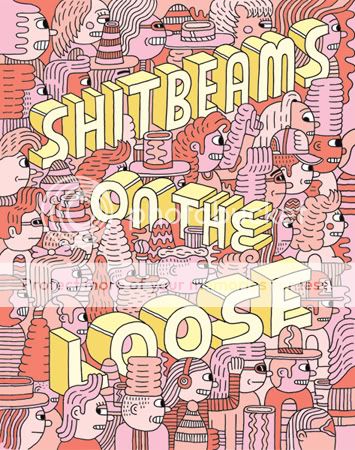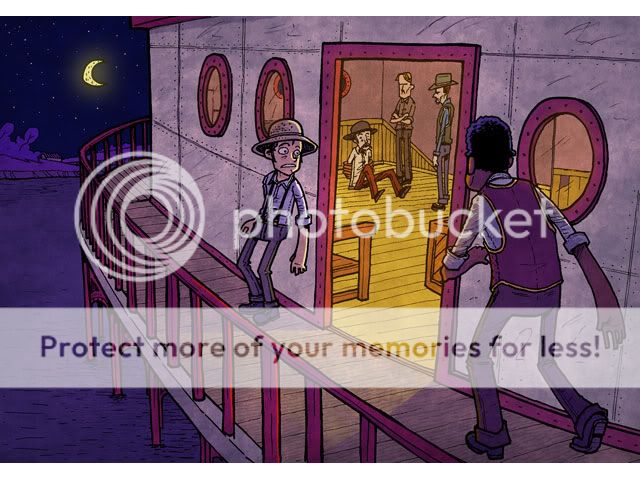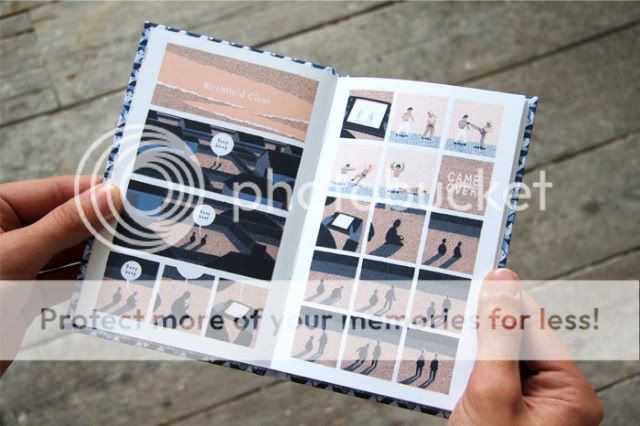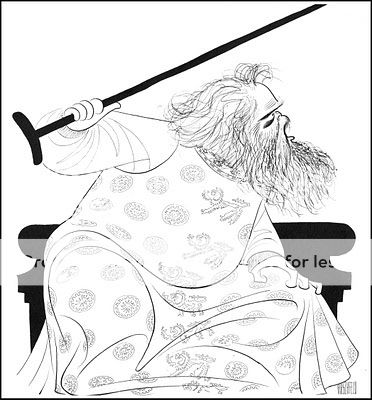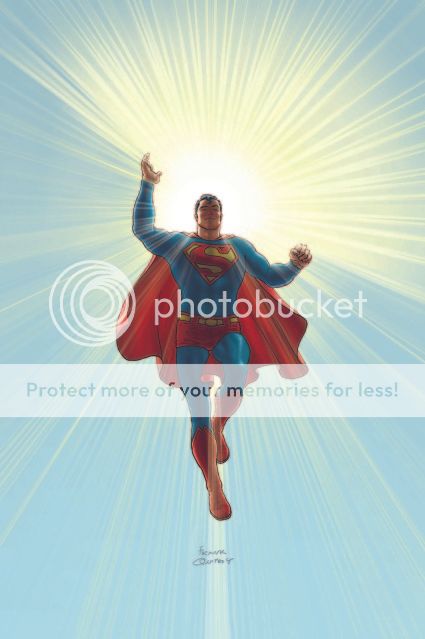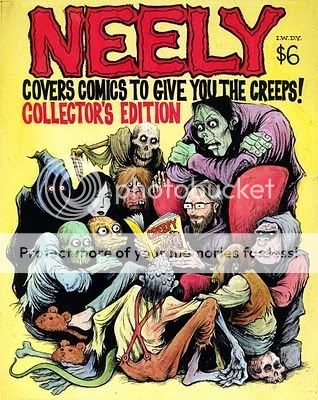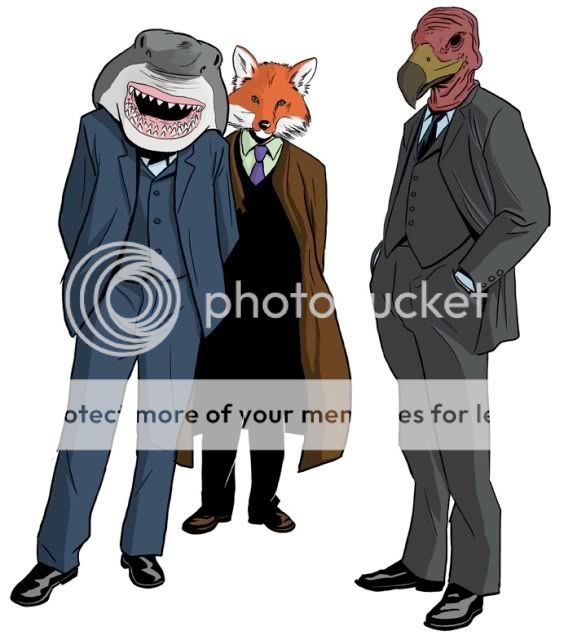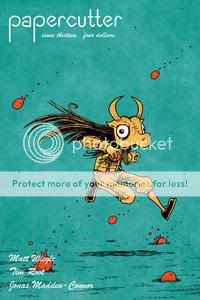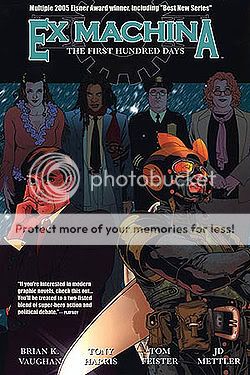Archive for June 30, 2010
Carnival of souls
June 30, 2010* Recently on Robot 6: So Wonder Woman is getting a new look and new origin. More reactions here. Best headline here.
* From the ridiculous to the sublime: Kevin Huizenga makes minicomics from scrap paper and uses them as sketchbooks.
* Matt Seneca on a variety of comics of interest, from those strange Silber Media ultra-minis to the Frazer Irving issue of The Return of Bruce Wayne (which I thought was hamstrung somewhat by how hard it was to tell Bruce apart from his equally jut-jawed, furrow-browed puritan antagonist).
* I read Paul Cornell and Pete Woods’s Action Comics #890 today and it was very entertaining. Here’s an interview with Cornell about it, conducted by my indefatigable, inescapable pal Kiel Phegley. It’s good that Cornell’s in DC’s bullpen in case, you know, certain things don’t work out.
* One other quick Superman note: I’ve been a supporter of the New Krypton material over the past couple of years, and I certainly enjoyed reading it as it came out, but I have to say the ending kind of smushed it all for me. That’s a lot of time to devote to a story in which the combined efforts of every character in the DCU who wears an S on their chest fails to save 100,000 people.
* In the interest of equal time, wow, that was a lot of talking in Avengers #2.
* Real Life Horror: Here and here you can find a pretty breathtaking look at how abjectly the four widest-circulation newspapers abandoned the plain-truth description of waterboarding as torture once the United States started doing it.
* Well holy smokes, look at this mash-up of Stanley Kubrick and Martin Scorsese movies. Here you have over seven minutes of scenes from basically the best movies ever made by my two favorite directors of all time. I could do a little dance, this made me so happy. SPOILERY AS ALL GET-OUT for GoodFellas, The Departed and probably lots and lots more besides. (Via everyone.)
Kubrick vs Scorsese from Leandro Copperfield on Vimeo.
Naked like the wolf
June 30, 2010Half exhausted from staying up so late on a work night, half delirious from the ambien I took to smooth my transition into beddy-bye once I got home (right, that’s the ticket), I discovered at the midnight screening of The Twilight Saga: Eclipse I went to last night that the movie flies right by. I’m reasonably sure this is actually true and not merely a product of my two-in-the-morning brain, and I’m reasonably sure it’s a compliment as well.
The two earlier installments of the series, Twilight and New Moon, were distinguished by their weird, physics-defying property of requiring a lot of time to do not so much. Both earlier films were dominated, after all, by sequences of Kristen Stewart’s Bella getting to know a hot boy who’s secretly a monster, sequences that took up what felt like over half of each film’s running time. In Eclipse, there’s not, like, a new hot mummy or Frankenstein or zombie or ghost kid for her to meet/stare at/be stared at by, so that portion of the narrative is gone.
The other really odd thing about the each of the first two movies is the detachment of the final-reel climax from, basically, the whole rest of the film. In Twilight you have a few scattered scenes involving the vampire trio who end up serving as ersatz antagonists, but their initial confrontation with the Cullen vampire family, their rogue member’s decision to hunt and kill Bella, his attempt to do so, and his death at the hands of the Cullens all takes place within approximately 20 minutes toward the end of the movie. New Moon is slightly better in this regard–Robert Pattinson’s Edward does at least mention, in passing, the idea of baiting the ruling super-vampire council the Volturi to should he ever want to kill himself, which is where things end up. But Edward’s first-reel fake-breakup with Bella and her loooooong subsequent getting-to-know-you stuff with Taylor Lautner’s teen wolf Jacob mean that once again, the showdown with the sinister vampire antagonists comes out of nowhere and is wrapped up rapidly. Eclipse breaks that pattern too. Pretty much from the jump, you and the characters know that Victoria–the female vampire from the initial film’s trio, now played by Bryce Dallas Howard in a bad wig and out for vengeance for the death of her mate at the Cullens’ hands–is breeding an army of powerful, out-of-control “newborn” vampires to storm Bella’s hometown, overwhelm the Cullens and the werewolf tribe, and murder Bella. So the Cullens and werewolves train to fight the newborns, the newborns attack and are defeated, and the inevitable Edward-Jacob team-up dispatches Victoria. The end!
So,yeah, Eclipse has a rather welcome sense of direction. Credit genre-vet director David Slade, perhaps? Certainly the 30 Days of Night helmer has fun with the sort of shattered crystal statue effect deployed here (for the first time in the series so far, because why the heck not) for what happens when you dismember a vampire, and with the series’ second conspicuous murder of a child while our heroes stand by and do nothing, and with a memorably nasty flashback of the werewolf tribe’s first encounters with “the cold ones.” Alas, two other key flashbacks aren’t as much fun: Our glimpses of the origins for Rosalie Cullen (Nikki Reed) and Jasper Cullen (Jackson Rathbone) explain why the former’s such an asshole and give the latter something to do other than look like a constipated Harpo Marx, but Rosalie’s “birth” is sexually violent in a way that brings author Stephenie Meyer’s sexual politics uncomfortably to the fore, while Jasper’s Civil War roots can be compared all too directly and unfavorably to True Blood. (Even if I kind of like the idea that there were small armies of vampires running amok in the South, just ‘cuz I can hear Shelby Foote describing this in my head. “Vampahs were fairly common throughout the Confederacy at this pahticuluh tahm…”)
But who cares about frou-frou shit like plot momentum and horror and decent vampire effects–what about the sturm und drang of young love? Eclipse is both the best and the worst of the series in that regard. The Bella-Jacob storyline, starring Kristen Stewart at her loveliest and Taylor Lautner at his most shirtless (apologies to Mike Nelson, Patrick Swayze, and Road House), is where the real emotional heat is. Jacob’s in that familiar, gut-churning position where he’s formed a powerful bond of love with someone…who just happens to love someone else even more. It’s a common enough situation for teenagers, whose hearts are bigger than their brains (apologies to Clark Griswold, Cousin Eddie, and National Lampoon’s Christmas Vacations) and often their consciences; it can feel good to have that second person to love, to use that person’s love for you, even as it feels horrendously painful for them, and by extension for you. In much the same way that it’s kind of gutsy for this series to go to bat for true teenage love, it’s also doing something here that you really don’t see very often, and good for it.
But the goodwill it engenders here is all but undone by the increasingly icky Bella-Edward relationship. It doesn’t help that Robert Pattinson is starting to suffer from diminishing returns–maybe it was just me or maybe it was how he was shot or made up, but in this movie he started looking less beautiful and more pouty and pasty, his face an immobile rubber mask. But the real problem is the bizarre message is sent by Edward and Bella’s quid-pro-quo relationship here. Edward wants to get married, Bella wants to become a vampire and to fuck Edward, so they essentially make an even exchange that once the former happens, the latter will, too. It’s unpleasantly, nakedly transactional, and it’s a perfect reflection of the simultaneous, stupid prudery and prurience of the faith-based abstinence movement. Save sex for your true love, it’s deeply wrong to have sex outside of marriage–so once you fall in love, get married in a hurry so you can fuck your brains out! It’s the first time the benightedness of Meyer’s ideas really knocked me out of the swoony broody young-love material. (Meanwhile, Bella’s entertaining quartet of human friends, particularly series MVPs Anna Kendrick and Michael Welch, were all but absent–we really could have used a healthy dose of their realistically hormonal hijinx.)
Given my wife’s Twatlight membership, I knew I was gonna be seeing this movie in the theater, one way or the other. And as was the case with New Moon, going at a time when going is an event unto itself was the way to go. The only way to go, I’d say. When you’re seeing this movie in the sort of audience where Jacob’s potentially fatal wounding and subsequent reversion from wolf to human form is greeted primarily with a collective moan of realization that holy shit he’s naked, you’re sort of borrowing eyes that look right past all the problems. They’re fun eyes to borrow, and necessary ones to boot.
Comics Time: Shitbeams on the Loose #2
June 30, 2010Shitbeams on the Loose #2
Andy Rementer, Ron Rege Jr., Jason Overby, Dave Nuss, Andrew Smith, Hector Serna Jr., Brent Harada, Robyn Jordan, John Hankiewicz, Grant Reynolds, Ryo Kuramoto & Amane Yamamoto, Rusty Jordan, Luke Ramsey, writers/artists
Rusty Jordan, Dave Nuss, editors
Revival House, October 2009
60 pages
$9
I picked this up on the strength of that gorgeous Andy Rementer cover, which at the time I thought was by Ron Rege Jr. That’s actually a pretty appropriate way to have discovered this artcomix anthology, in which there are several pieces strong enough to make you think “hey, this was worth taking a flyer for nine bucks” and several others that you could mistake for the work of other cartoonists and then some stuff that you just move on by. I’m always up for new John Hankiewicz, and thus my favorite piece is his wordless sequence of four full-page images, which paint a quietly creepy portrait of some kind of dark domestic fairy-tale. It’s followed by some bravura inkwork by Grant Reynolds in service of a gruesome underwater flying-saucer sci-fi tale, peppered with non sequitur quotes in big block letters that feel like faintly received transmissions from the strip’s helmeted voyager. And I was tickled by both Dave Nuss’s look at the underpaid centurion who stabbed Christ in the side and the stylized drawing of “tubgirl” (google at your own risk) that Andrew Smith provided for the back cover. Beyond that? There’s some not-his-best stuff from Rege (really, this time), a “comic about comics” from Jason Overby whose visuals fail to live up to insight of the text, and some stuff that’ll remind you of Ben Jones, Matt Furie, Michael DeForge, Bald Eagles, you know, the whole wildandwoolier end of that scene. It’s inessential, but if you like this sort of thing, it’s the sort of thing you’ll like.
Carnival of souls
June 29, 2010* New Ignatz books at long last!
* This month, Partyka’s Guest Artist is…Partyka’s Matt Wiegle, who in addition to daily sketches is posting his sumptuous illustrations for Barnes & Noble’s Sparknotes series. This one’s from Huckleberry Finn.
* “Fired HEROES Writer-Producer Jeph Loeb To Run Marvel Entertainment’s TV Division!!” I’d say “‘Nuff said,” but at the link, AICN’s Hercules makes an interesting point regarding the relative creative roles of Loeb and Tim Kring on that show, too.
* Today on Robot 6: Octopus Pie‘s Meredith Gran proves it’s a different world than where you come from, yes it is now, yeah.
* Real Life Horror: An American torture conviction, of sorts.
* Forget the colorforms gimmick aspect: I’d take either half of the cover for Superman: The Man of Steel #30 as-is and be perfectly happy. Wouldn’t you?

* Matthew Cheney takes a long stroll through the glorious Rambo: First Blood Part II for The House Next Door. More on that to come…
I don’t have much of a use for Hot Topic, but I like that it exists.
This is because it democratizes punk by commodifying it. If you’re a thirteen year old from the suburbs, you don’t need to run the gauntlet of gate keepers to invest in a subculture; you just need to convince your mom to drop $20 on a t-shirt for you. Liberating!
Amen, except for the part about not having much use for Hot Topic–I started shopping there as an adult. (Via Nate Patrin.)
Without reaching to the Soviet bloc for examples, one case of such an artificial and untenable code is the American demand that all politicians be monogamous and drug-free. The press both creates this untenable expectation and exploits violations in order to entrench its power over the political system.
The demand that political journalists either not hold, or never express, their own political opinions is another such artificial and untenable code. Politically interested actors who attempt to enforce this code by revealing the private convictions of reporters do not have the moral goal of ensuring that political reporters have no political opinions; such a goal would be absurd. Rather, they aim to aggrandise their power over journalistic organisations by exacerbating the hypocrisy of those organisations’ official codes of conduct, and then exploiting evidence of that hypocrisy when useful.
A while back I realized why the press focuses so much on “hypocrisy,” and “flip-flopping.” In the “he said/he said” framework that the establishment media deems the only acceptable way to convey news, it’s verboten to discuss whether what either side “said” is factually accurate, let alone practically desirable, let alone morally sound. No, the only standard to which any political actor can be held is the standard he sets for himself. Thus, the gravest sin a politician can commit is “flip-flopping” from a previously articulated position, even if this is the result of a perfectly rational evolution of opinion rather than some craven cave-in to the prevailing political winds. In the eyes of the establishment press, you’re much better off holding and sticking with a completely odious position than you are ever changing your mind one way or the other. (Via Andrew Sullivan.)
* Which leads me to, of all things, the buried lede of this Carnival: Night Business/Gangsta Rap Posse‘s Benjamin Marra and No Trivia/Are You a Serious Comic Book Reader’s Brandon Sodeberg talk Rambo: First Blood Part II for The House Next Door as well. If you read Marra and watch the kinds of movies I do and care about the sort of movie action and violence I care about, you’ve probably already clicked over. But I want to talk about this line from Ben:
In comics, there’s a lot of evidence of devaluing entertainment and fun, especially within the current indie and underground spheres, instead focusing on a tone of pseudo-artistic seriousness and pretension.
Ben says this sort of thing all the time, like in every interview he does. And I eat up all of his comics and all of his interviews with a spoon. Yet at the same time, when I see bloggers say stuff like that, dismiss huge swathes of alternative comics by reducing them to an easily mocked stereotype, I pretty much flip out. What’s up? Well, here’s the part where I’d take a page from Tom Spurgeon and say it’s okay for an artist to say things we wouldn’t accept from a critic if those things are obviously said in service the sort of art they make. In terms of his personal satisfaction as a comics reader or his utility as a critic, I think he’s shooting himself in the foot by writing off alternative comics, but that’s not the issue. Po-faced trash is what gets Ben fired up as a creator, and he’s excellent at making it himself, so it’s hard to hold his biases against him.
But wait! I’ve done exactly that when I’ve seen other artists pull similar stunts–cf. my reaction every time Alan Moore lambastes Hollywood filmmaking in one breath while saying he doesn’t watch any of it with the next, or dismisses superhero comics as a creatively bankrupt regurgitation of other people’s ideas. What’s the difference? Well, it’s specific to Moore. Here’s a guy who’s made his career out of drawing sophisticated adult ideas from pop, pulp, trash, and kids’ stuff, whether we’re talking about Marvelman, Watchmen, Lost Girls, The League of Extraordinary Gentlemen, even From Hell to an extent. That makes it extra-frustrating when he dismisses today’s pop/pulp/trash out of hand, or acts as though he has a principled objection to working with other people’s ideas.
So what’s the difference between me saying this and people making fun of John Kerry? I like to think that in my case, first of all, the “hypocrisy” angle isn’t nearly as important as whether or not good or crap art is made as a result. I’d be perfectly happy to attack or defend Moore as an artist rather than as a person who did one thing but said another. Moreover, it’s not just the hypocrisy that rankles, it’s the fact that Alan Moore, of all people, oughta know better, right? We expect more from him because he’s displayed such a nuanced understanding of how much is really going on under the surface of storybooks and Victorian adventure novels and Captain Marvel knock-offs and Ripperology and on and on and on. So in the end the comparison with Marra’s oft-articulated viewpoint on literary comics isn’t even the right one to make–it’d be more apt if Marra was making Night Business while dismissing Rambo, not dismissing, I dunno, Asterios Polyp.
* Oh yeah: Benjamin Marra drew a picture of Sylvester Stallone in Cobra.
Carnival of souls
June 28, 2010* Joe Quesada talks digital royalties with Kiel Phegley. Kiel swings by the comments of my related post on Robot 6 to explain why he asked what he asked and didn’t ask what he didn’t ask. Warning: horrifying fanboy entitlement ahead!
* Also on Robot 6 today: Tom Brevoort vs. Wizard.
* My chum Jason Adams saw Neil Marshall’s Centurion last night–JEALS–and begins his review thusly:
I went into Centurion last night with my friend Sean’s Manly Movie Mamajama series on my brain, and ended up judging it by those exacting standards. As such, it’s pretty successful.
SOLD!
* I was travelling today so I haven’t had a chance to sink my teeth into Jog’s interview with Bryan Lee O’Malley…raincheck!
* Ditto (for the most part) Matt Seneca’s look at Josh Cotter’s masterpiece Driven by Lemons. I still think it’s a little hard to believe that my two favorite comics of last year, this and Al Columbia’s Pim & Francie, were both the products of debilitating mental illness.
* I got a kick out of this Cracked list of 5 ridiculous things guns do in movies that they don’t do in real life. I wonder how many untold millions of dollars have been thrown away on the great silencer scam. (Via Jason Aaron.)
* Wait, Jeffrey Brown is illustrating that Paul Is Undead Beatles-zombie book?
* Really digging the look of the cover for Geoff Grogan’s next project, Mystique. No, not that Mystique. Well, not quite.
* I cannot in any way endorse the writing attached to i09’s gallery of He-Man and the Masters of the Universe concept art by Earl Norem — it’s frankly shameful — but I sure as shit can endorse the gallery itself. (Via Kiel Phegley.)
* I can’t post Rickey Purdin’s Matt Furie/Boy’s Club fanart on this blog because I need to keep it a vomit-free zone for the Missus, but it’s somethin’ special.
Comics Time: not simple
June 28, 2010not simple
Natsume Ono, writer/artist
Viz Signature/Ikki, January 2010
320 pages
$14.99
I’m gonna go so far as to say don’t waste your time with this one. Sure, the cover makes it look like an imported slice-of-lifer of the sort that’s at least surface-level appealing to American altcomix readers like me. But inside is a story so rife with tragedy, maudlin melodrama, and ludicrous implausibility it feels less like, say, Solanin and more like something you’d waste a couple Saturday afternoon hours watching on Lifetime. Its confusing intro at first makes the book seem like it’s going to be about a totally different person and scenario and then gets barely a dozen pages before lobbing the first in an onslaught of absurd coincidences, all of which come in lieu of a plot that emerges organically from character. When we finally do get around to telling the story of our protagonist Ian–a young man recovering from abuse and hoping to reunite with the older sister he suspects was secretly his birth mother–it quickly becomes clear that Ono’s art isn’t up to the task she sets up for herself, in which the characters’ appearances and who looks like whom are a major plot point. She’s not really making up for it with style or layout either: Her angular line and big-eyed emo-haired impossibly slim characters are pleasant enough for a time, but they wouldn’t look out of place in an undistinguished minicomic being sold at a MoCCA table, and her panels feel cramped and at times illogically placed. There’s a comparatively strong, thoughtful, intriguing subplot-cum-A-plot involving a young writer who befriends Ian with the intention of writing a novel about his tragic life but quietly falls in love with him. It nearly rights the ship, but only nearly, especially once it’s capsized once again by the most over-the-top plot twist of the lot. I’ll say this for the book: it reads like a breeze–even if that’s in part because the art is slight and you’re racing through the narrative since it doesn’t reward dwelling.
Carnival of souls
June 25, 2010* The great Brian Chippendale on Marvel’s new Avengers line. Nobody does it better. Read it all the way through to the end–it’s worth it.
* A graphic novel by Nathan Fox? Sure, I’ll eat it.
* Oooh, this book Birchfield Close by Jon McNaught looks lovely. (Via Kevin Huizenga.)
* Al Hirschfeld. Look on his works, ye mighty, and despair. (Via Tom Spurgeon.)
* Just a rumor, but I’d be quite thrilled if Peter Jackson were to direct the two Hobbit movies himself.
Comics Time: It Was the War of the Trenches
June 25, 2010It Was the War of the Trenches
Jacques Tardi, writer/artist
Fantagraphics, March 2010
120 pages, hardcover
$24.99
Just a few observations on the art here:
1) With the exception of the introductory story, this entire book features three tiered panels per page. In superhero comics this format is known as “widescreen”; it connotes power. It’s powerful here, too, but it’s a power to oppress and crush rather than soar or punch in action-movie style. They’re like miniature trenches.
2) In one memorable sequence early in the book, soldiers leap up from their trench and charge their opposite numbers. Their charge is depicted against a blank white background in lieu of any kind of detail for the sky or the horizon. You see men cut down by invisible bullets–no speed lines, no blurs, certainly no enemy firing.
3) One particularly strong page in the sequence uses panels of two soldiers leaning forward to sandwich a grisly shot of a soldier being blown backwards–hat flying off and blood streaming out behind him–by a bullet to the head.
4) Tardi’s art frequently piles detail on detail–meticulously researched trenches filled with the detritus of war, huge gatherings of massed soldiers in impeccably drawn uniforms and toting forests of guns and bayonets–but one thing he rarely if ever does is bury his protagonists in the visual cacophony. Flipping through the book, it’s impressive how he uses various tricks to pop them out from their surroundings. Most frequently, he’ll use the device of having people face directly out at the reader in weird little pseudo-portraits of them against their backgrounds. This is where the strength of his portraiture–his signature taciturn squinty-eyed stubbly everymen–comes in.
5) But he also uses a lot of forward motion, characters moving or leaning from the left-hand side of the panel to the right, serving as guideposts for your eyes and thus standing out to you.
6) It’s actually interesting to see the cases where people face right to left instead. I don’t think it’s always used for effect–it’s not like every single time is like that famous sequence from Safe Area Gorazde where Sacco drew people fleeing through a forest from right to left, “against the grain” of the reading experience if you will, to drive home the difficulty of their journey. But flipping through, I see some notable cases–a man seizing a suspected traitor, wounded Englishmen leaving the front, two soldiers from opposite sides of the conflict hiding out in a basement together, a soldier who gets lost in No Man’s Land sitting and trying to figure out which way to head…in most cases it suggests an inability to escape.
7) The whole book seems smeared with zipatone, dingy and dreary, like you’re being rained on. It makes the un-shaded parts–that attack sequence, a series photo-like images of the wounded and disfigured veterans toward the end–practically radiate from the page.
All of which is to say that this is Tardi’s thesis, as articulated in his foreword:
There are no “heroes,” there is no “protagonist” in this awful collective “adventure” that is war. nothing, but a gigantic, anonymous scream of agony.
…and but for my own personal history I’d be tempted to dismiss this as Captain Obvious territory. But the specific and unique awfulness of World War I is that trench warfare by its very nature highlights the pointlessness of the deaths of its participants: Untold thousands upon thousands of men standing up, moving forward a few feet, and being blown to pieces, gaining no ground, rinse, repeat for years on end. Add to this the French experience of many many soldiers being executed by their own side on entirely spurious or totally unfair accusations of dereliction of duty, a duty that was frequently impossible for them to execute. Tardi is brining very specific and very effective weapons to bear in his chillingly successful effort to convey this particular horror.
Carnival of souls
June 24, 2010* Today on Robot 6: What’s up with Marvel’s digital-royalties plan? For more, see Heidi MacDonald.
* Matt Maxwell waxes ecstatic about Escape from New York. It’s like one of his con reports, but from deep inside the prison colony of a dystopian future.
* Rough chuckles ahead for the I Hit It with My Axe gang. I really wonder what the heck could make something like that seem like a good idea to the participants.
😉 In all seriousness, now that day-and-date digital is happening with both big companies to one degree or another, I’d like to hear what Dirk makes of it. Do you think it’s just a frogmarch to the death of the DM at this point?
* Always up for new Noel Freibert comics.
* Your quote of the day comes from Tom Spurgeon on the presence of non-genre mass media stuff at Comic-Con:
For me, a movie like Avatar and a television show like Glee have the same amount of crossover interest with comics: none. Your comics may have vampires and werewolves in them but my comics have aging local talk show hosts and southern California post-punk culture in them. I don’t understand why your interests are more legitimate in terms of seeing them represented by offerings in other art forms than mine are.
* More music should sound like Goldfrapp. Actually it’s quite easy to construct a mindset wherein Goldfrapp is the logical conclusion/fulfilled promise of the Glitter Band, electroclash, and Doctor and the Medics doing “Spirit in the Sky,” and I would encourage you to do so.
Carnival of souls: Special “DC digital day-and-date download” edition
June 23, 2010* Gamechanger part deux: DC Comics unveils its own digital-comics plan. This includes an app for the iPad and iPhone, plus digital comics available through comiXology and PlayStation and eventually the DC website to boot. The 26-issue biweekly series Justice League: Generation Lost is going day-and-date immediately (y’know, if you’ve been wondering whether we’d see moves toward that sort of thing by the end of the year or anything). The company is also publicly announcing the existence of creator royalties for digital sales, though of course no figures. (Kudos to Matt Maxwell for being the first person I saw to notice all this.)
* My colleague Kiel Phegley talks to Co-Publisher Jim Lee and digital honcho John Rood about the move, and my colleague Kevin Melrose has the best reaction roundup I’ve seen.
* Today at Robot 6: Megan Kelso talks turkey about the New York Times Funny Pages.
* MK Reed interviews Tom Neely on the Henry Rollins/Glenn Danzig slashfiction minicomic Henry & Glenn Forever for the Beat. Hilarious and heartbreaking money quote:
In 3 weeks we sold more HG4Evers than I’ve sold of The Blot in 3 years. I’m really happy for this books success, but it has caused some conflicting emotions about success and art.
But Tom announces on his blog that the second printing will include 12 new strips, so that’s good news. I think.
* Lost “news” I’m posting today because I wasn’t sure, I figure some other people might not be either: Today I did some googling and learned that that epilogue featuring So-and-So and Such-and-Such will indeed be on the Lost Season Six DVD set, not just the Complete Series set.
Comics Time: Peter’s Muscle
June 23, 2010Peter’s Muscle
Michael DeForge, writer/artist
self-published, May 2010
12 pages
no price listed
The second panel in this comic, a view of the buildings lining a city street–here, you can see it yourself–literally made me say “whooo” out loud on the train. Yeah, I’m quite frankly impressed as hell by what I’ve seen from Michael DeForge so far. This minicomic contains two nightmarish short stories, both of which pivot off of characters from popular comics (Spider-Man and freaking Foxtrot respectively) as is DeForge’s apparent wont, and they’re maybe the tightest things I’ve seen from him yet. The first involves Spider-Man recounting to his therapist a sex dream he had about Aunt May and Doctor Octopus; it’s not a “haha look the famous corporate icon is doing something dirty” joke, it’s a way to make this sort of uncomfortable Freudian stuff even more up-close-and-personal by using the familiar visual vocabulary of a hugely popular pop-culture staple to keep everything painfully simple to understand. The second shows a loinclothed character wandering through a wasteland whose geological features seem to consist solely of viscera, killing a phallic animal, and offering its disembowled corpse to the colossal, godlike, bifurcating head of a cute comic-strip kid. Again, this kind of “cute thing doing gross thing” material might read as overly broad in less skilled hands, but DeForge appears in complete control of his line, his figurework, his character designs, his backgrounds, his use of zipatone, his cartoony satirical representations of Spidey and Doc Ock and Aunt May, his pacing, his punchlines, his choice of nightmare imagery (sidewalk-as-thin-membrane is gonna be hard to shake when I walk to the comic shop today)…it’s very, very sharp, it does exactly what it wants to do.
Carnival of souls
June 22, 2010* BREAKING: RETURN OF THE KING RIFFTRAX NOW AVAILABLE
* Alex Dueben speaks with Megan Kelso at length about Artichoke Tales, one of those Black Hole/Big Questions-style decade-in-the-making graphic novels, as well as pretty much the entirety of her career.
* I’m glad Ken Parille decided to un-delete his post on “hyper-aggressive misreading” by critics, i.e. when someone goes completely buckwild on a book in a fashion that’s both disproportionate to the offense and ultimately inimical to actual insight–into the book, that is; it provides plenty of insight into the creator. Be sure to read the comments, too–the first sentence of the first response made me laugh out loud.
* Is the new AT-AT the greatest toy in the history of mankind?
* The best part about this Walking Dead set-visit report is that it heavily features Ian Anderson from Jethro Tull, who was visiting the set the same day.
* Mark Waid makes a funny at J. Michael Straczynski’s expense.
* Good on Paul Cornell for signing an exclusive with DC–I look forward to his Lex Luthor book–but count me among the millions upset that this is a definitive no on further Captain Britain and MI-13.
* Here’s a cute reminiscence from Anne Groell, editor of George R.R. Martin’s A Song of Ice and Fire series, about her long history with the books. Sounds like Book Five is…well, I don’t wanna say imminent, but… (Via Tower of the Hand.)
* My favorite LCD Soundsystem song is probably “Sound of Silver,” in large part because James Murphy’s vocals sound like Heaven 17’s. Turns out that was exactly what he was going for. I dunno, I get really excited when I accurately trainspot. The aforelinked Fresh Air interview with NPR’s Terry Gross comes via Matthew Perpetua, who pulls the following killer quote from Murphy on the sort of hipster-band checklist at the end of “Losing My Edge”:
At the end, the reason why I yell all the band names, is because I suddenly realized that this is what you do when you know things. Knowing things, knowledge, or your attachment to things, your self-association with other bands, or books, or whatever. It’s often like this weird amulet that protects you. Like “No, I am serious, look at my library, listen to this!” I can list all the books I’ve read, and now you know I am a serious person. And so it’s just supposed to be this amulet swinging around me to protect me from being seen as anything I didn’t want to be seen as.
* Go buy a bunch of mostly decent, mostly recent superhero paperbacks, as well as assorted manga and a bunch of Bacchus and 30 Days of Night stuff, for super-cheap in Barnes & Noble’s big bargain graphic-novel sale.
Carnival of souls: Special “disconsensus” edition
June 21, 2010* Jeet Heer discusses Dan Nadel’s new mostly action-oriented anthology Art in Time and makes the following very-worth-discussing point:
But Dan wants to shake up our sense of history. I’ve taken the issue up with him during a panel in TCAF and he’s made the point elsewhere as well but in essence he’s challenging the view of old fogeys like me who see a major epistemological break between the world of commercial comic books and the world of the undergrounds. For Dan, it is all comics, and the formal properties that unite Marsh and Sharon Rudahl (for example) outweigh the social, cultural and economic divide.
[…]
Still, and this might be a testimony to my age and the extent that I was formed intellectually in the 1980s when the divide between commercial comics and the alternative press was especially large, I’m not sure I fully buy the argument Dan is making in Art In Time. It seems to me that the undergrounds did represent a fundamental break with the past. I’m not sure if I can define it in words, but the best underground comics (Crumb, Deitch, Spiegelman, Justin Green) cut deeper into human experience than any of the commercial cartoonists, no matter how good they were, ever did. The experience of reading an underground comic is different from reading a commercial comic book. Even with the best commercial comics, you have to make allowances or read between the lines to find the spark of individuality.
Man, there’s some heavy stuff going on in there. I think it’s pretty clear that from a critical-consensus standpoint, Heer has lost this particular argument. In large part, the task of the ’00s in both critical and comics-making terms was reclaiming commercial and genre comics as subjects worthy of investigation and capable of holding their own with the art/lit/underground end of things. Obviously, in his dual role as both critic and publisher, Nadel arguably represents the apotheosis of that viewpoint.
* This argument of course has parallels with poptimism vs. rockism in music criticism; nowadays you couldn’t possibly say that “the best underground music cut deeper into human experience than any of the commercial musicians” without being laughed off of Tumblr, and rightly so, because that’s a ridiculous statement. (I understand that the music and comics industries of the mid-20th century aren’t directly analogous, but that’s why we have analogies.) And of course this isn’t very different from the critics who fought for the legitimacy of rock and roll, or jazz, or from the Cahiers crowd taking Hollywood seriously as art, and on and on and on.
* (It’s worth considering, of course, that the reason people like Nadel, or me, can treat genre and commercial comics seriously is because the previous generation of critics fought so hard against genre and commercial comics to make room for alt/art/lit/underground books in the discussion. With that work done, we can go back and fill in the gaps. Nadel’s compatriot Tim Hodler said as much at SPX a while back.)
* All that being said, what I worry about as the next generation of critics comes up is that the availability of genre/commercial comics to them in terms of something that’s seen as okay to talk about seriously is once again crowding out the conversational space for nongenre/noncommercial comics. Pop quiz: Can you name more than one critic who writes mostly, or even often, and well about alternative comics who wasn’t already doing so three years ago? I think there’s a fairly large generation gap in terms of who’s talking about what, especially in internet terms.
* (NB: It’s entirely possible I’m an insulated idiot who’s missing out on someone totally obvious and awesome, so it’s worth noting that this is not a rhetorical question. If I’m being stupid, help me be less stupid.)
* Related, in some way: Stereogum assembled a fascinating artists’ roundtable on art-pop duo CocoRosie’s latest album Grey Oceans, the gist of which is essentially that dude-ism is preventing people from taking the band as seriously as they should be taken. To a certain extent I think this is seeing hoofprints and thinking “zebra”: The woman with the mustache’s voice is certainly an acquired taste, and I’m sure that’s what turns a lot of people off of the band. (Also, the indie-rock press is always super-excited to throw accusations of racism/sexism/homophobia/classism at itself, which is oddly hilarious to me.) But what CocoRosie does is not soooooooo weird that it’s not within the boundaries established by countless other weirdos in the indie-rock world, and moreover no one’s making the argument that the masses are unfairly ignoring the band–they’re saying this is being done by critics, who in theory ought to be able to handle ’em. Indeed it’s weird to me that the consensus hasn’t lined up in their favor beyond the usual “naw, this isn’t for me” responses anything gets. I think there’s something to that, and I wanna say that the one commenter who explodes with rage and flings around phrases like “these sisters stink like bullshit” is an indication that the roundtable hit a nerve. (No, not in the comic-convention-panel “if people hate it, then good, we’re doing something right” way…it’s just clear all sorts of baggage and preexisting resentment is being brought to the table, as is the case nine times out of ten when a critic substitutes anger for insight.)
* Also related, maybe? James Murphy of LCD Soundsystem on artists and age:
Pitchfork: Okay, you’re old. How do you think your age informs your music?
JM: I think it’s a huge part of it. I’ve kind of been thinking about this a lot lately. Because for a while I was really angry. ‘Cause I was like, “What the fuck? We should suck. We should be being wiped off the stage by kids every night.” I just didn’t get it. I spent years saying that and being kind of wound up. Like, where the fuck are the kids? Then I started thinking that energy that used to be kids– early rock and then punk, what was really going on was that there was no marketing to kids.
If you made advertisements, you made them to 40- or 50-year-olds. Because they had money, they had jobs. You didn’t advertise to kids. The only thing that was targeted to kids was like, funny hair products and rock’n’roll. So you had this one thing to navigate, and that was where all your energy was.
But now kids buy shit. They really buy shit. Kids buy designer stuff. So you’re being constantly pounded by marketing. And if you want to be a rebel, well, there’s rebel clothing companies. There’s rebel stick-on tattoos. You can get a rebel skateboard. You just pick your rebel mode and there’s a whole online shopping network that you can be a part of. So kids may look punk or feel punk, but what they’re kind of doing is the same as like, being really swept up in high school sports or something. But when I was a kid, you didn’t know. I was like, “I guess Kraftwerk is punk?” I remember I got Sex Pistols, Kraftwerk’s Computer World and Venom on the same day. And I thought it was all punk. It was just everything that was weird. Everything that wasn’t Bruce Springsteen– who turns out to be a lot punker than I thought at the time.
So I just think it takes a couple decades to kind of clear your brain now. So it makes more sense to me that I could find my footing when I was 30 instead of when I was 19. It seems a little more clear. You know, novelists are older now. Things are happening later in people’s lives. They’re kind of living lives and then creating things about the lives they’ve lived. Rather than being an artiste at an early age and coming out with a ball of fire. That energy has been co-opted because you haven’t immunized yourself yet against media. It’s easier to get swept up things then take a couple of years to get over your, like, indie rock hangover. I’m scraping the fucking Quarterstick Records crust out of my eyes when I’m like, 27. You know, “Why am I playing in 5/7? How is that fun?”
* My chum Kiel Phegley interviews DC Comics co-publishers Jim Lee and Dan DiDio for CBR.
* On Robot 6 I pulled out a couple of passages that struck me: One in which DiDio pushes back against the outcry over the death of the Asian-American Atom, Ryan Choi by saying in part “to focus on one book, one issue, is doing a true disservice to the company, the comics and to the industry”;
* and one in which DiDio and Lee discuss their interaction with Vertigo.
* I think it’s worth reading Ben Davis’s piece on Brian Chippendale’s show at the Cinders Gallery for the Village Voice and Kurt Shulenberger’s piece on Super Mario Galaxy 2 for The House Next Door in tandem. I think the Mario games may be the single most underdiscussed work of art of the past 30 years relative to their innovation, influence, and fecundity. (Chippendale link via Heidi MacDonald.)
* Ron Rege Jr. explains how the aptly named Yeast Hoist #15 is both a comic and a beer.
* Anders Nilsen proposes some things to consider.
* Frank Quitely says “Subtext? What subtext?” on the cover for Absolute All-Star Superman.
* Marvel must be quite pleased with the sales for Avengers #1.
* I really dug the way Tucker Stone broke down what’s appealing and unappealing alike about Amazing Spider-Man since it went almost-weekly in his piece on Savage Critics from a couple days ago. It’s certainly worth reminding ourselves of the parade of massively talented artists that’s traipsed in and out of that series over the past couple of years.
* Immune though I am to the ring-a-ding-ding Rat Pack nostalgia that is Darwyn Cooke’s bread and butter, I nonetheless got a lot out of Matt Seneca’s unpacking of Cooke’s work through a single Parker panel.
* Here’s a nice little piece by Shawn Despres in the Japan Times about glo-fi/chillwave, my favorite microgenre since electroclash. (Via Mark Hogan.)
Comics Time: Neely Covers Comics to Give You the Creeps!
June 21, 2010Neely Covers Comics to Give You the Creeps!
Tom Neely, writer/artist
I Will Destroy You, May 2010
24 pages
$6
Tom Neely’s “cover versions” of various classic (or in some cases just old) horror comic covers have been a highlight of the Internet ever since he started putting them up on his site and on Robert Goodin’s never-miss-a-day Covered site. So naturally a collection of them is gonna be a treat if you’re into that sort of thing. But I think this minicomic is worth the price admission for more than just horror-hound eyecandy.
For one thing, it’s more like an eye-dessert cart, in large part due to the colors. People ought to be studying that lush midnight blue background in Adventures Into Terror, that sickly purple twilight in Beware the Clutching Hand and Unearthly Spectaculars, the candlelight effect giving way to a rich orange shadow in Creepy #79. That the comic’s paper holds them as well as it does is a testament to Neely’s skill as a self-publisher in addition to his instincts as a colorist.
For another, this collection is a sort of capsule version of the horror gospel according to Tom Neely. Not so much in the selections as in the interpretations, a picture emerges of what it is that Neely finds frightening; put simply, it’s the vulnerability of the body. His figures are both rail-thin and out-of-shape, a brand of body horror not far removed from black-and-white photos of the prisoners of Andersonville or Auschwitz. They grasp and point with arms that look like they could be snapped in half like twigs–honestly, Beware the Clutching Hand could serve as the title for Neely’s whole oeuvre. And there’s a horror of hair here as palpable as anything outside of The Ring. Weedy black locks cascade out from the heads of women like snakes and sprout from the heads and faces of men like anemones, suggesting an intense loathing of the way our bodies behave beyond our control. It’s like a zombie apocalypse perpetrated by sentient armpits and groins. All told, it’s much more than a series of kitschy nostalgic pin-ups. Creepy? You betcha.
Carnival of souls
June 18, 2010* New Azure Ray album in September!!! Three exclamation points, which is three more than the album will use.
* Why don’t let’s take a stroll through Jim Woodring’s Weathercraft with Ken Parille.
* In the latest episode of Zak Smith/Sabbath’s I Hit It with My Axe: Pigs on the wing!* Real-Life Horror: The culture of death.
* The Republican Party’s repeated intimations of militarization have disturbing implications.
Comics Time: Pluto: Urasawa x Tezuka
June 18, 2010
Pluto: Urasawa x Tezuka
Naoki Urasawa, writer/artist
Takashi Nagasaki, writer
Based on Astro Boy: The Greatest Robot on Earth by Osamu Tezuka
Viz, 2009-2010
Eight volumes
200 pages or so each
$12.99 each
I was over the moon for the first three volumes of Pluto, suspense mangaka Naoki Urasawa’s Watchmen-style reimagining of a classic Astro Boy storyline–and for precisely the same reasons lots of other smart critics weren’t. I love stories about emotionally wounded men (or in this case, robots) crying over the death of puppies and children. I love stories about people paralyzed by grief and loss. I love stories about people who lay it all on the line, and lose it all, to save other people, and then how those other people handle being the reluctant beneficiaries of that sacrifice. In a word, I love melodrama. If it involves robots, so much the better. And in Pluto, I felt for the first time that Urasawa was connecting with something more than mere story.
Ultimately the series fails to fully live up to the magical magisterial melodramatic pomp of that first volume. As I found to be the case with Monster (although certainly not to that extent), Urasawa’s technique of drawing out characters’ climactic realizations and confrontations for page after page eventually dilutes their impact. In this particular case, the murder mystery at the story’s heart ends up being solved in a fashion that’s both disappointingly straightforward in terms of motive and unnecessarily, distractingly complicated in terms of execution. And since this is a super-robot story, the climax must come about through combat, ironically the one thing that Urasawa’s visual vocabulary does not enable him to portray in the most thrilling of all possible ways; particularly given the environment in which the final battle takes place, it’s difficult to get a handle on where you are, what’s going on, or what the consequences for each beat might be. Like the characters whose fate will be determined by the battle’s outcome, you just have to take it on faith that the involved parties know what they’re doing and things will come out in the end.
That said, the robots, and their surreally obtrusive appearances in Urasawa’s meticulous blend of realism and slick cartooniness, never ceased to be a joy to look at and never stopped lodging themselves in my brain. The repeated use of flashbacks to horrible events that haunt the main characters had that same effect on me. I came to care about these people/”people”–well, more like I came to be intrigued by them. I wanted to find out what happened to them to make them the way they are, and for things to work out for them, and I was frequently surprised when things went bad way before I thought they would. And in the end I appreciated the book’s blend of deep, unshakable, even scientific pessimism about human nature with an impassioned insistence that we can reject that programming if we try–in a fashion that’s a lot more convincing than the similar moral throughline in Monster, by the way. It may not stick the landing, but it’s a thing of beauty in flight.
Carnival of souls
June 17, 2010* The new Scott Pilgrim trailer is the best Scott Pilgrim trailer ever!
* Also on Robot 6 today: I love Dennis Culver’s Batman villain drawings. If I could draw them like that, that’s all I’d do.
* Matt Wiegle covers Papercutter‘s lucky thirteenth issue.
* The takeaway from Chris Oliveros’s Chicago Printers Row report: The book collection of Anders Nilsen’s Big Questions will be 650 pages long and hit in 2011.
* Mike Barthel writes about Daniel Clowes’s David Boring in such a way as to suggest he ought to get acquainted with Kevin Huizenga’s post on the comics argument he never wants to hear again.
* Speaking of Huizenga, wanna see a cute comic about his creative process?
* And Now the Screaming Starts’ CRwM unmasked! Now I know who to slap with my glove for all those smartass comment-thread comments.
* Adam Grano is smurfing the dream.
* Like Rob Bricken, I really thought they Narnia movies were dunzo until I saw a big cardboard cutout promo for one in the movie theater a couple weekends ago and realized it was for a new one.
* Rest in peace, Garry Shider. The Starchild has been called home to the Mothership.
Carnival of souls
June 16, 2010* This interview of Benjamin Marra by GQ’s Alex Pappademas is really fabulous for a variety of reasons, even beyond the fact that it’s an interview with Benjamin Marra in GfuckinQ. First of all, it’s the longest interview with Marra I’ve seen so far. Second, it was done over the phone rather than by email, so you’re getting more or less unadulterated Marra as himself, rather than the more studied “man of art, man of lust” voice you get whenever he sits down in front of a keyboard. Third, because it’s long and because it’s done in real-time, it goes in all sorts of directions–like this part, which may be the most interesting thing I’ve ever seen anyone say about, of all things, True Blood:
I think about that show True Blood, which is this awesome sex and violence soap opera, it’s total cult stuff, and people love it–and that’s done by Alan Ball, who’s done some really arty kinds of things.
Right. American Beauty and stuff. And now he’s doing this show–and I say this positively–that’s complete trash, in a lot of ways.
Yeah! And that’s the reason why I like it so much. It’s not apologetic in any way. It is what it is and it makes no bones about it. It’s really just stripped-down, basic, well-executed entertainment.
I remember talking long, long ago about Invasion U.S.A. and how difficult it would be today to recapture that level of unthinking mayhem without resorting to Shoot ‘Em Up-style ugly self-consciousness. I think the two great arguments that no, this can be done are the Crank series and the comics of Benjamin Marra.
* Much like the Bavarian Illuminati, Kevin Huizenga is spreading his shadowy tentacles throughout the whole Internet: In addition to his regular blog, and his drawing club’s blog, and his recently unearthed Fight or Run blog, and all the goodies he’s got hidden on USSCatastrophe, he also has a blog I hadn’t seen before called New Construction, which focuses on “cartooning practices and concerns.”
* At the latter, he’s got a great post up on Bushmiller, Nancy, iconicity, and “pure cartooning,” the gist of which is (I think) that it behooves us to divorce value judgments from our descriptions of the relative simplicity or complexity of a cartoonist’s visual style. “Maybe it’s as simple as wanting to keep clear the distinction between description and prescription,” he says. Smart stuff that reminded me of his last push back against the notion of “pure cartooning”, which he brings back up himself.
* And he takes a little time out to call out the default mode of dismissing alternative comics.
* Oh yeah, here’s another blog, where Huizenga and his wife list the books they’ve read.
* Ron Rege Jr.’s Yeast Hoist #15 is a beer. Not even kidding. Could I love him more?
* Do not read this unless you’ve read all the books, but George R.R. Martin’s latest blog post reveals that he wrote a certain chapter in a certain book last even though it wasn’t the last chapter in that book, which makes a lot of sense given what happens in it.
* Why don’t let’s take a stroll through Psycho with Ali Arikan.
* This Sunday sale at Jim Hanley’s Universe in NYC is one of the nuttiest things I’ve ever heard of: You buy a longbox for $25 and can stuff it with as many back issues as it can hold. Frank Santoro, clear your calendar.
Comics Time: Ex Machina Vols. 1-9
June 16, 2010Ex Machina Vols. 1-9
Brian K. Vaughan, writer
Tony Harris, artist
with John Paul Leon, Chris Sprouse, artists
DC/WildStorm, 2005-2010
various page counts
$12.99 each
There’s something lovably clunky about Ex Machina. Before we get to the lovably, let’s talk about the clunky, from the ripped-from-NPR political factoids that in some cases all but replace actual dialogue to the silent-movie mugging and gesticulating of Tony Harris’s photoref’d art. In my re-read of the series in three or four sittings prior to its imminent conclusion with issue #50, I was struck by just how clunky it is, particularly at first–much more so than I remember it.
Those first few issues get over largely on the strength of Brian K. Vaughan’s unfuckwithable high concept, the most button-pushing such idea in a career already full of them: Main character Mitchell Hundred is a New York City civil engineer whose contact with a mysterious artifact gives him the ability to communicate with machinery, inspiring him to launch a second career as a masked vigilante which culminates in his diversion of the airplane aimed at the second tower on 9/11 and leads to his election as mayor months later. So strong is that final page of the first issue, with one tower standing next to the light beam used to memorialize the second, that it’s easy to forget how Hundred’s politics are a “both sides make good points” centrist-pragmatist-contrarian hodgepodge that’s both unwieldy and unconvincing. Having the aforementioned both sides shout their points at Mitchell and one another via his various advisors, staffers, and constituents doesn’t help matters, especially because they’re usually concocted in such a way as to smack you over the head with “hey look how ideologically diverse this city is, you can’t pigeonhole anyone, we’re here to challenge your preconceptions, it’s not as simple as Left/Right black/white etc etc.” If you meet a priest, you can bet he’ll also be a boxer who takes the Lord’s name in vain; if a gay couple’s gonna get married, you’re damn straight they consist of one of the city’s, like, eight black firefighters and a Log Cabin Republican. Meanwhile they all point and shrug and flail about like they have some sort of neurological condition. It’s quite silly-sounding and silly-looking at times.
And yet! Just because a choice of how to write or draw something isn’t the choice I would have made doesn’t mean those choices can’t work on their own terms. For example, I always preferred Ex Machina to the other BKV book written in this vein, Y: The Last Man, because of Pia Guerra’s stiff art on the latter–even though I think that stiffness, that neither-fish-nor-fowl not quite naturalistic not quite cartoony look that was Vertigo’s house style for so long, is a big part of what makes that book such a hit with people new to comics: It’s simple and clear, yet not “childish.” Rereading Ex Machina this time around, I had a few flashes of suddenly thinking “Guerra Was Right”: Maybe her simplified, styleless figures are the perfect vehicles for Vaughan’s dialogue in his sociopolitically tinged series, where complex ideas are boiled down into streamlined approximations thereof in much the same way. Maybe Harris’s almost fumetti-like fealty to his models is what makes Vaughan’s Trivial Pursuit: Fiorello LaGuardia Edition dialogue feel so weird here and there.
But you know what Harris does have, in spades? Style, even glamour. Compared with the white glare of that other famous photorealist, Alex Ross, Harris’s art is awash in thick blacks that seem to make his figures both shine and swirl, and their eyes light up the room like Ellen DeGeneres’s when your’e watching American Idol in HD. (Seriously, that woman has unbelievable Lord of the Rings eyes.) Their world of constant grinning and shouting may be one uncanny valley removed from our own, but it’s still a world it seems like it’d be fun to hang out in, argue in, get embroiled in a political crisis or hostage situation in. It’s buoyant, it’s bright, and even the recurring grand-guignol violence feels like some sort of pop-art explosion as much as a series of brutal murders.
And in reading all nine of the currently collected volumes back to back, I discovered so much to enjoy about Vaughan’s writing, or more specifically his plotting. I’d never noticed before that each arc features a masked “villain” of some sort, even if it’s more likely to be someone who stole a fireman’s outfit from the set of Third Watch than a genuine “bad guy.” I also never picked up on the fact that while Hundred and his confidants self-consciously refer to Jack Pherson–a super-powered stalker who gained the ability to communicate with animals in an attempt to crack and duplicate Hundred’s power–as his “arch-enemy,” the book also features a real arch-enemy in the sense of a character plotting behind the scenes to take Hundred down for pretty much the series’ entire duration. In other words, like many heroes, Hundred has a “fighter” arch-enemy and a “thinker” arch-enemy. And by contrast with so many serialized genre entertainments of the past decade, the mythology elements are doled out so judiciously I’d forgotten they even existed. Seriously, you can go for twenty issues at a time before a given reference to the mystery of Hundred’s powers is repeated or followed up on; I can think of at least one very major one from the book’s second arc that still hasn’t been mentioned again. Once you get into it, even the speech becomes easy to enjoy. Vaughan clearly has a blast cussing, for one thing. Moreover, behind the didactic dialogue lurks the satirical concept that the only way to power through the avalanche of ossified bullshit that is politics and government is for a superhero to essentially bully people into it.
But it’s important to note that Vaughan in no way thinks this is a good idea. Indeed, the real secret to Ex Machina‘s success for me is that Vaughan announces, from the first page (set after Hundred’s term ends; everything that follows is a glorified flashback), that the story is a tragedy. Hundred’s personal heroism and political maverickiness will all end in unspecified disaster, perhaps for him, perhaps for the whole city–and as the issues go by, it seems possible that it’ll end in disaster for the whole world. All the characters who argue and chuckle and backslap their way through this whole NYC morality play have no idea what kind of story they’re actually in, but we do. Some rough beast is slouching toward Gracie Mansion, and the tension between the zesty surface gestures and the dark heart beneath is what will ultimately make these ten volumes worth returning to.
Carnival of souls
June 15, 2010* From the moment I saw it, there was no doubt in my mind that this wonderfully violent red-band trailer for Neil Marshall’s Centurion would be today’s lead item. Two words: General McNulty.
* This hidden cache of scanned comics by everyone from Crockett Johnson to Dave Kiersh on Kevin Huizenga’s website is like the find of the year for me. Sadly, my attempt on Robot 6 to drum up other such treasure troves was mostly a bust.
* Ali Arkan’s piece on Joe Dante’s Gremlins 2: The New Batch makes me think that movie was even blacker than I rememeber. Arkan’s fast becoming one of my “sure, I’ll eat it” film critics.
* Here’s a fine tribute to five books published by Buenaventura Press from Matt Seneca. This panel-by-panel look at Frank Quitely’s work in Batman #700 is worth your time too.
* Very cool map of the Lost island by Jonah Adkins. I remember loving the hell out of the last Lost map this guy did. Click to enlarge. (Via Jason Adams and io9.)

